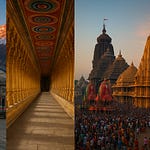A Temple Beyond Time
Nestled on the banks of the holy Kshipra River in the ancient city of Ujjain, the Mahakaleshwar Jyotirlinga Temple is one of the most sacred and revered temples of Lord Shiva in India. It is not merely a place of worship but a cosmic center where faith, time, and liberation converge. Counted among the 12 Jyotirlingas, Mahakaleshwar holds a unique position as it is the only south-facing (Dakshinamukhi) Jyotirlinga, signifying its power to liberate devotees from death and the cycles of rebirth.
Origin and Foundation: The Birth of Mahakal
The term Mahakaleshwar derives from two Sanskrit words — Maha meaning “great” and Kala meaning “time” or “death”. Mahakal is the ultimate destroyer of time, the controller of life and death, the one who stands outside the bounds of cosmic cycles.
According to Hindu scriptures and Puranic legends, a five-year-old boy named Shrikar, deeply devoted to Lord Shiva, wished to bring him to Ujjain. He was ridiculed, yet his steadfast devotion, along with that of a herder named Vridhi, moved the Lord himself. Eventually, when Ujjain was under threat by a demon named Dushan, Lord Shiva appeared as a blazing pillar of light and destroyed the demon to protect his devotees. It is said that Shiva took the form of Mahakal, and at the earnest request of devotees, decided to stay in Ujjain eternally, in the form of a self-manifested (Swayambhu) Lingam.
Historical Timeline and Glorious Past
The Mahakaleshwar Temple has seen centuries of glory, destruction, and resurrection:
Prehistoric and Vedic Times: Ujjain (then called Avantika) is one of the seven Moksha-puris. Its spiritual roots trace back to the Vedic age, and the Mahakal Lingam is believed to have existed even then.
Paramara Dynasty (9th–13th century CE): The original temple was significantly expanded under King Udayaditya and his son Naravarman. They added sculptures, mandapas, and cultural vibrancy to the site.
13th century (1293 CE): The temple was destroyed by Sultan Iltutmish during his invasion. However, the Lingam, being underground and Swayambhu, remained untouched.
Maratha Period (1734 CE): The temple was rebuilt in its present form by Ranoji Shinde, the general of Peshwa Baji Rao I, under the guidance of Pandit Narayan Dikshit. This marked a cultural revival in Ujjain and brought renewed spiritual fervor.
Modern Day: The temple is now maintained by a committee under the Madhya Pradesh Government, and remains a vital epicenter of Shaivism and spirituality.
Architectural Grandeur: Symbolism in Stone
Built in Bhumija, Maratha, and Chalukyan styles, the five-storey temple radiates grandeur. Its dark stone spire, intricate carvings, silver-plated doors, and majestic Nandi Hall reflect spiritual and artistic brilliance. The underground Garbhagriha holds the Jyotirlinga, surrounded by a sanctum that resonates with powerful energy.
The Dakshinamukhi lingam faces the south, a rare feature symbolizing Mahakal’s power over Yama (God of Death). Above the sanctum is the Nagchandreshwar Temple, which opens only once a year on Nag Panchami.
Religious Importance: The God of Death Who Grants Life
The Mahakaleshwar Temple is believed to be the only Jyotirlinga that grants Mukti (liberation) from the fear of death. In the Katha of Shiv Purana, it is said that by worshipping Mahakal, one is freed from all sins, the cycles of karma, and achieves ultimate moksha.
Ujjain is considered the navel of the Earth in Indian cosmology, and Mahakal is its protector. It is also said that time flows from Mahakal, and thus he is known as the “Lord of Time”.
Devotees, sages, and seekers come here to pray for longevity, peace of mind, and spiritual elevation.
Puja and Rituals: Divine Order of Worship
One of the most spiritually charged rituals is the Bhasma Aarti, performed every morning at 4:00 AM, where the lingam is worshipped with sacred ash (bhasma) — traditionally from a cremation pyre, symbolizing the transient nature of life and Shiva’s dominance over death.
Key rituals include:
Abhishek with Panchamrit – Milk, curd, honey, sugar, and ghee.
Bhasma Aarti – Only temple where this Aarti is performed.
Maha Rudrabhishek – For intense spiritual benefits.
Laghu Rudra Path – To remove doshas and attain well-being.
Shravan Maas Celebrations – A month dedicated to Lord Shiva.
Nag Panchami and Mahashivratri – Grand festivals attracting lakhs of devotees.
Only male devotees in traditional attire (dhoti, no upper cloth) are allowed inside the sanctum during Bhasma Aarti.
What to Do and What Not to Do
What to Do:
Attend the Bhasma Aarti after prior registration. It’s life-changing.
Visit the Nagchandreshwar Temple during Nag Panchami.
Perform Abhishek with pure intentions and under guidance.
Maintain silence and reverence in the Garbhagriha.
Meditate near the Kshipra River for spiritual solace.
What Not to Do:
Do not wear black or revealing clothing.
Avoid bringing non-vegetarian food or alcohol anywhere near.
Photography is restricted in the inner sanctum.
Do not touch the lingam unless permitted or guided by priests.
Do not interrupt ongoing rituals.
Significance in a Devotee’s Life: Mahakal as the Ultimate Refuge
For countless devotees, Mahakal is not a distant deity but a guardian, a father, a savior. People believe Mahakaleshwar to be the final resort for those troubled by disease, distress, fear of death, and sins.
In spiritual psychology, Mahakal signifies the letting go of ego, the end of illusion, and surrendering to a force that governs all.
Many have reported miraculous recoveries, inner peace, and life transformations after visiting the temple.
Mysteries and Legends
Bhasma Aarti with cremation ash has deep Tantric significance, practiced nowhere else.
The Swayambhu Lingam is believed to emit vibrations, especially during midnight or Shivratri.
Ujjain is considered the city of Kal (Time), where Mahakal is said to sit above even the planetary influences (Navagraha).
The temple well, Koti Tirtha, is said to possess healing energies.
Legends say even Shri Krishna and Balarama studied in Ujjain under Rishi Sandipani, visiting Mahakal frequently.
Best Time and How to Visit
Best Time: The temple is open year-round, but visiting during:
Mahashivratri (Feb-March)
Shravan Maas (July-August)
Nag Panchami (once-a-year opening of upper sanctum)
…offers unparalleled spiritual experience.
Timings:
Temple opens at 3:00 AM and closes around 11:00 PM.
Bhasma Aarti: Entry begins at 2:00 AM, ends by 6:00 AM.
Travel Guide:
Nearest Airport: Indore (approx. 55 km)
Rail: Ujjain Junction is well-connected.
Road: Accessible via buses and taxis from Indore, Bhopal, or nearby cities.
Local hotels range from budget to high-end, and many dharamshalas offer religious accommodation.
Where Time Meets Eternity
Ujjain Mahakaleshwar is not just a temple — it is a living embodiment of time, death, rebirth, and liberation. To visit Mahakal is to stand at the doorway of the eternal, where even the ticking of time halts, and the soul experiences what is timeless.
For saints, Mahakal is the final frontier. For scholars, he is a symbol of destruction and rebirth. For devotees, he is the compassionate guardian who removes fear, grants blessings, and holds their hand through the storm of life.
To walk into Mahakaleshwar is to walk into yourself — raw, real, and reborn.










